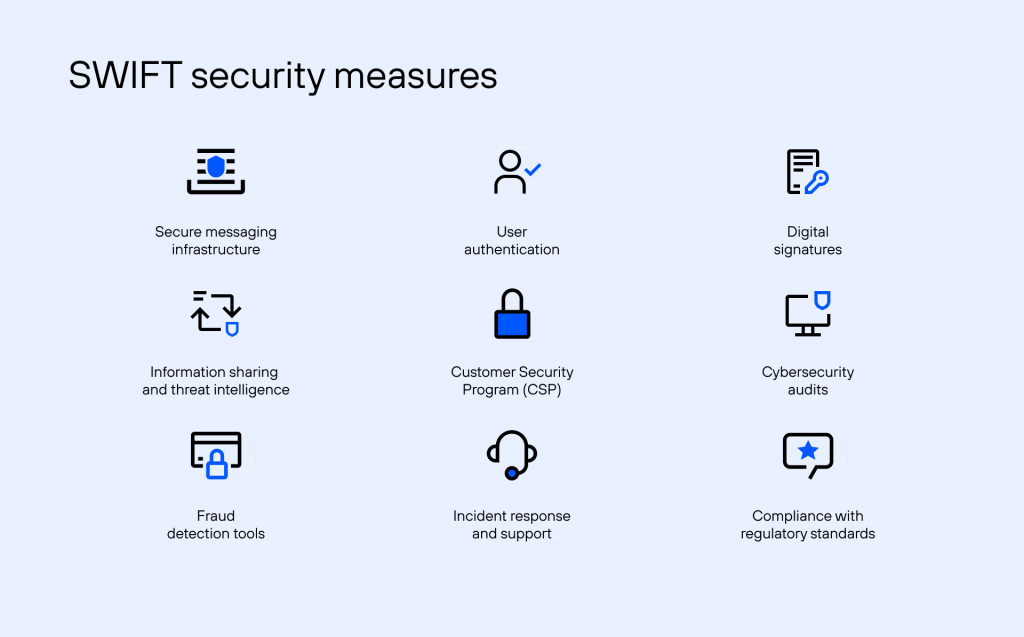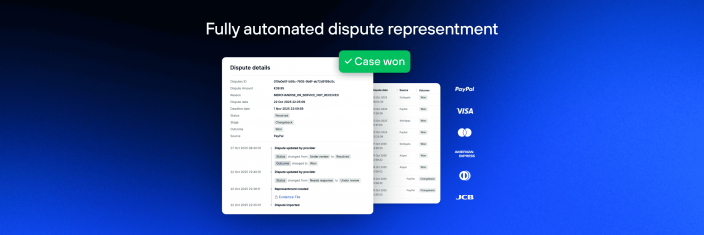Transactions with Swift Payments System: Fast, Secure, and Efficient

SWIFT (Society for Worldwide Interbank Financial Telecommunication) is a trusted and widely-used messaging network that connects banks and financial institutions around the world. Whether you’re sending money across borders, receiving funds from abroad, or engaging in other cross-border financial activities, SWIFT’s robust infrastructure and network provide a reliable foundation for your transactions. In this article, we are going to explore the SWIFT system and break down how it works.
Table of Contents
Who Can Benefit from SWIFT and Its Range of Services
SWIFT’s services cater to a broad spectrum of entities involved in international financial transactions, including corporations, banks, government entities, and payment service providers.
- Banks and Financial Institutions: Banks and financial institutions are the primary users of the SWIFT network. They can benefit from SWIFT’s messaging services, connectivity solutions, and supplementary services to securely and efficiently exchange financial messages, process transactions, and manage international payments.
- Businesses and Corporations: SWIFT enables them to make secure and timely payments to international suppliers, receive funds from overseas clients, and manage treasury operations efficiently.
- Government Entities: SWIFT enables secure communication and coordination between central banks, facilitating interbank settlements, foreign exchange operations, and other financial activities. It also supports regulatory reporting and compliance efforts.
- Payment Service Providers: Payment service providers can leverage SWIFT’s services to expand their reach, improve transaction speed and transparency, and offer reliable international payment solutions to their customers.
Explanation of SWIFT Payments
SWIFT payments facilitate the transfer of funds between different banks or financial institutions worldwide. Here’s an in-depth explanation of how SWIFT payments work:
- Initiation: The sender, known as the originator, provides the necessary information to their bank to initiate the SWIFT payment. This includes the recipient’s bank name, address, account number, SWIFT code, and the amount to be sent.
- Sender’s Bank Processing: The sender’s bank, also called the originating bank, receives the payment instruction and verifies the provided information. They ensure that the sender’s account has sufficient funds to cover the transfer and may apply any relevant fees or charges.
- Message Creation: The originating bank generates a SWIFT message, typically using the SWIFT message format MT103, which contains all the relevant details of the payment, including the sender’s and recipient’s information, transaction amount, currency, and any additional instructions.
- SWIFT Network Transmission: The originating bank sends the SWIFT message to the SWIFT network. The message is securely transmitted over the SWIFT network infrastructure, which connects participating financial institutions worldwide.
- Intermediary Banks: If there are intermediary banks involved in the payment, the SWIFT message is routed through them. Intermediary banks are used when the sender’s bank does not have a direct relationship with the recipient’s bank. Each intermediary bank deducts its fees (if applicable) and forwards the payment message to the next bank in the chain.
- Recipient’s Bank Processing: The recipient’s bank, also known as the beneficiary bank, receives the SWIFT message. They verify the recipient’s account details, ensuring the payment is directed to the correct beneficiary. The recipient’s account is credited with the transferred funds.
- Notification and Crediting: Once the payment is received and processed by the recipient’s bank, they notify the recipient that the funds have been credited to their account. This can be done through various means, such as email, SMS, or a notification within the recipient’s banking platform.
- Payment Settlement: In parallel to the messaging process, the actual settlement of funds between the participating banks takes place through correspondent banking relationships. Settlement typically occurs through the debiting and crediting of accounts maintained by the banks with each other or through a centralized clearing system.
- Confirmation and Reconciliation: The originating bank receives confirmation from the recipient’s bank that the payment has been successfully credited to the recipient’s account. This confirmation helps ensure the payment has reached its intended destination. Both the originating and recipient’s banks reconcile their records to ensure accurate accounting and tracking of the transaction.
SWIFT provides a secure and standardized messaging network, enabling financial institutions to exchange payment instructions and facilitate cross-border transactions. It ensures transparency, reliability, and compliance with regulatory requirements, making SWIFT payments a widely adopted method for international fund transfers.
Understanding SWIFT Code and IBAN
A SWIFT code is a unique identification code used to identify a specific bank or financial institution in international transactions. It is a standard format consisting of a combination of letters and numbers and is 8-11 characters long. The code provides information about the bank’s city, country, and branch.
IBAN is an internationally recognized format for bank account numbers. It is used to identify individual bank accounts in international transactions. The IBAN format varies across countries but typically includes check digits, a country code, and the account number itself.
Essentially the SWIFT code tells you which bank to pay, and the IBAN tells you which individual bank account to pay to. Often you will need both the recipient’s SWIFT code and IBAN to conduct an international transaction.
SWIFT’s Supplementary Services: What Are They
SWIFT offers supplementary services that complement its core messaging and connectivity solutions. These services provide additional functionalities and value-added features to financial institutions and including the following:
Compliance Services: Helping You Stay Compliant
SWIFT Compliance Services encompass a range of solutions to help financial institutions meet regulatory requirements and managing financial crime risks. These services are designed to enhance the security, transparency, and integrity of financial transactions conducted through the SWIFT network and include:
- Sanctions Screening
- Know Your Customer (KYC)
- Anti-Money Laundering (AML)
- Counter-Terrorism Financing (CTF)
- Fraud Prevention
- Regulatory Reporting
Connectivity Services: Connecting You to the Network
Connectivity Services refer to a suite of services provided by SWIFT that enable financial institutions to connect to the SWIFT network securely and efficiently. These services ensure reliable and standardized communication between participating banks/ Here are some key components of Connectivity Services:
- SWIFT Alliance Messaging Hub (AMH): AMH is a secure, scalable, and high-performance messaging platform offered by SWIFT. It serves as the backbone for connecting financial institutions to the SWIFT network.
- SWIFTNet Link: SWIFTNet Link is a connectivity option that allows financial institutions to connect their internal systems directly to the SWIFT network.
- SWIFTNet VPN: SWIFTNet VPN (Virtual Private Network) is a secure network infrastructure provided by SWIFT. It enables financial institutions to establish encrypted connections over the public internet, ensuring data confidentiality.
- SWIFT Access Solutions: SWIFT offers different access solutions tailored to the specific needs of financial institutions. These include Member Concentrator, Lite2, and Shared Infrastructure Program (SIP).
Global Payments Innovation: Enhancing Your Cross-Border Payments
SWIFT Global Payments Innovation (gpi) is an initiative by SWIFT that enhances the transparency, speed, and traceability of cross-border payments. It provides end-to-end tracking of payments, faster processing times, and increased visibility into fees and foreign exchange rates, improving the overall customer experience in international transactions.
SWIFTRef: A Global Reference Data Service
SWIFTRef is a comprehensive reference data platform created by SWIFT. It offers a wide range of standardized reference data services to facilitate accurate and efficient financial transactions. SWIFTRef provides access to essential information such as bank identifier codes (BICs), International Bank Account Numbers (IBANs), standing settlement instructions, and legal entity identifiers (LEIs). This reference data is crucial for banks and financial institutions to ensure accurate routing, compliance, and counterparty identification in their cross-border payments, securities, and treasury operations.
MyStandards: Simplifying Messaging Standards Management
MyStandards is a platform provided by SWIFT that helps financial institutions standardize and manage their messaging and integration processes. It provides a collaborative environment where banks can access and maintain their message formats, market practice guidelines, and other documentation related to SWIFT messages. MyStandards enables efficient message validation, compliance checks, and testing, ensuring smooth communication and interoperability between different financial institutions connected to the SWIFT network. It helps reduce complexity and enhance efficiency in global financial transactions.
SWIFT Integration Platform: Facilitating System Integration
The SWIFT Integration Platform (SIP) is a solution provided by SWIFT that enables financial institutions to integrate their internal systems with the SWIFT network. It serves as a central hub for secure connectivity, message transformation, routing, validation, workflow orchestration, and monitoring, facilitating seamless communication and data exchange between banks and the SWIFT network.
Empowering International Employees with SWIFT
SWIFT (Society for Worldwide Interbank Financial Telecommunication) provides various services and solutions that can empower businesses with international employees, including:
- Efficient Salary Payments: Through the SWIFT network, businesses can initiate international wire transfers, ensuring that employees receive their salaries in a timely manner, regardless of their location.
- Currency Conversion: SWIFT supports currency conversion allowing businesses to convert salaries into the local currency of the employee.
- Compliance and Security: SWIFT incorporates robust compliance and security measures, ensuring that businesses can securely transfer funds to their international employees.
- Enhanced Efficiency and Accuracy: SWIFT’s standardized messaging formats and automation capabilities streamline payment processes for businesses with international employees. This reduces manual intervention and minimizes errors.
- Global Reach: SWIFT’s extensive network spans across numerous banks and financial institutions worldwide. This global reach allows businesses to reach international employees regardless of their location.
Make Your Transactions More Secure

SWIFT employs several measures to enhance the security of transactions transmitted through its network, including:
- Secure Messaging Infrastructure: SWIFT utilizes a secure messaging infrastructure that employs industry-standard protocols and encryption techniques to protect the confidentiality and integrity of messages. Encryption ensures that data transmitted over the network remains unreadable to unauthorized parties.
- User Authentication: SWIFT requires strong user authentication to prevent unauthorized access. Financial institutions must implement secure authentication mechanisms, such as secure tokens or digital certificates, to verify the identity of users accessing the SWIFT network.
- Digital Signatures: SWIFT supports the use of digital signatures to validate the authenticity and integrity of messages. Digital signatures provide a means to verify that a message originated from the claimed sender and that it hasn’t been tampered with during transmission.
- Information Sharing and Threat Intelligence: SWIFT facilitates the sharing of information and threat intelligence among its member institutions. The SWIFT Information Sharing and Analysis Centre (ISAC) enables members to exchange information on cybersecurity threats.
- Customer Security Program (CSP): SWIFT has introduced the Customer Security Program to enhance the security posture of its member institutions. The CSP mandates a set of security controls and practices that members must implement.
- Cybersecurity Audits: SWIFT conducts cybersecurity audits and assessments of its member institutions to ensure compliance with security requirements. These audits help identify vulnerabilities, assess security controls, and provide recommendations to further enhance security measures.
- Fraud Detection Tools: SWIFT offers fraud detection and prevention tools that help financial institutions identify suspicious or fraudulent activities within their SWIFT transactions. These tools use behavioral analysis, anomaly detection, and rule-based monitoring to identify potential fraudulent patterns.
- Incident Response and Support: SWIFT maintains a 24/7 Security Operations Center (SOC) to monitor and respond to security incidents. In case of a security breach or suspicious activity, the SOC provides timely support, guidance, and coordination to assist member institutions.
- Compliance with Regulatory Standards: SWIFT aligns with international regulatory standards and guidelines related to security and data protection. This includes compliance with General Data Protection Regulation (GDPR) and anti-money laundering (AML) and know-your-customer (KYC) processes.
By implementing these security measures, SWIFT aims to make transactions transmitted through its network more secure, protecting the integrity and confidentiality of financial data and reducing the risk of fraudulent activities.
Alternatives to SWIFT: Other Options
There are several alternatives to SWIFT that have emerged in recent years, offering different approaches to cross-border payments and financial services. Here are some notable examples:
- TransferWise (now known as Wise): Wise is a peer-to-peer money transfer platform that provides low-cost international transfers with transparent fees. It uses a network of local accounts to facilitate transfers, bypassing traditional correspondent banking networks.
- Cross-Border Interbank Payment System (CIPS): CIPS is a Chinese interbank payment system established by the People’s Bank of China. It aims to facilitate efficient and secure cross-border payments in Renminbi (RMB) by providing a direct clearing and settlement infrastructure.
- Cryptocurrencies: Cryptocurrencies, such as Bitcoin and Ethereum, offer alternative methods for cross-border transactions. These decentralized digital currencies leverage blockchain technology to conduct peer-to-peer transactions without intermediaries like traditional banking systems.
- NIUM (formerly InstaReM): NIUM is a global payments platform that offers businesses and individuals the ability to send and receive money across borders. It provides competitive exchange rates and supports multiple currencies, making it a convenient option for cross-border payments.
- Airwallex: Airwallex is a global fintech company that offers a cross-border payment platform for businesses. It provides businesses with access to multi-currency accounts, international payments, and foreign exchange services, streamlining their global financial operations.
These alternatives differentiate themselves through factors such as cost-effectiveness, speed, transparency, and ease of use. However, it’s important to evaluate each option’s specific features, limitations, and regulatory considerations when choosing the most suitable alternative for specific cross-border payment needs.
Pros and Cons
SWIFT allows you to send money securely around the world. However, the system is not perfect and does have some drawbacks. Here are the key pros and cons of SWIFT:
Pros of SWIFT:
- Global Reach: SWIFT provides a vast network connecting financial institutions worldwide, enabling efficient and secure communication for cross-border transactions.
- Standardization: SWIFT enforces strict messaging standards, ensuring consistency and interoperability across different financial institutions, reducing errors, and facilitating straight-through processing.
- Security: SWIFT employs robust security measures to protect the confidentiality and integrity of transmitted data, including encryption, authentication protocols, and secure messaging infrastructure.
- Established Infrastructure: SWIFT has been a dominant player in the financial industry for decades, with a mature and reliable infrastructure trusted by banks and financial institutions globally.
- Regulatory Compliance: SWIFT helps financial institutions meet regulatory requirements by providing messaging services that facilitate compliance with regulations such as anti-money laundering (AML) and know-your-customer (KYC) guidelines.
Cons of SWIFT:
- Cost: SWIFT’s services come with associated fees, including messaging fees and connectivity costs, which can be significant, especially for smaller financial institutions and organizations with high message volumes.
- Processing Time: Cross-border transactions through SWIFT can take several days to settle due to the multi-step process involving correspondent banks and intermediaries, which can result in longer transaction times compared to newer alternatives.
- Lack of Transparency: SWIFT messages may not provide real-time visibility into the transaction status or detailed information on fees and foreign exchange rates, which can limit transparency and make it challenging to track and reconcile transactions
- Limited Innovation: SWIFT’s legacy infrastructure and standardized messaging formats may be perceived as less agile compared to emerging technologies and fintech solutions that offer faster, more innovative approaches to cross-border payments.
- Dependency on Correspondent Banks: SWIFT transactions often involve multiple correspondent banks, leading to increased complexity and potential delays or errors in the settlement process. The involvement of intermediaries can result in higher costs and potential operational risks.
SWIFT Generating Revenue
SWIFT generates revenue through numerous sources, including:
- Messaging Fees: SWIFT charges its members, typically banks and financial institutions, a fee for sending and receiving messages over the SWIFT network. The fee structure is based on the volume and types of messages exchanged.
- Service and Software Fees: SWIFT offers additional services and software solutions to its members, such as SWIFTRef (reference data platform), SWIFTNet messaging services, and compliance-related tools. These services often come with subscription or usage fees, generating revenue for SWIFT.
- Connectivity Fees: SWIFT provides secure connectivity options for its members to connect to the SWIFT network. These connectivity solutions, including leased lines, VPN, and cloud-based connections, involve fees based on the chosen connectivity option and usage.
- Training and Certification: SWIFT offers training programs and certifications to individuals and institutions to enhance their understanding of SWIFT messaging standards and technologies. These training programs come with associated fees.
- SWIFT Institute: The SWIFT Institute conducts research and publishes reports on various topics related to the financial industry. It collaborates with academic institutions and researchers. While specific revenue details are not publicly disclosed, the SWIFT Institute may receive funding through sponsorships, partnerships, or research grants.
SWIFT is a member-owned cooperative, and any surplus generated by SWIFT is reinvested into the organization to maintain and develop its infrastructure, services, and standards.
A Practical Solution for Optimizing Your Payments with SWIFT
By following these best practices, merchants can optimize their payments via SWIFT, improving operational efficiency, reducing errors, and ensuring smooth and secure cross-border transactions:
- Efficient Messaging: Ensure that payment messages sent via SWIFT adhere to the required standards and contain accurate and complete information. Use standardized message formats and codes to enhance interoperability and minimize errors.
- Straight-Through Processing (STP): Implement STP capabilities to automate payment processing and reduce manual intervention. This helps streamline operations, minimize errors, and expedite payment settlements.
- Connectivity and Infrastructure: Maintain reliable and secure connectivity to the SWIFT network. Ensure that your infrastructure, including hardware, software, and network components, is robust and properly maintained to support uninterrupted SWIFT communication.
- Message Validation and Compliance: Validate SWIFT messages for format, content, and compliance with regulatory requirements. Implement validation checks to ensure that messages meet the necessary criteria before transmission, reducing the chances of rejections or delays.
- Timely Reconciliation: Regularly reconcile payment data with your internal systems to identify discrepancies or exceptions promptly. Prompt reconciliation helps detect and resolve issues, ensuring accurate financial reporting and minimizing the risk of payment discrepancies.
- Security Measures: Implement robust security measures to protect SWIFT transactions and related data. This includes secure user authentication, encryption, intrusion detection systems, and monitoring tools to safeguard against unauthorized access or fraudulent activities.
- Relationship Management: Maintain strong relationships with correspondent banks and financial institutions that are part of the SWIFT network. Effective communication and collaboration help resolve issues efficiently and ensure smooth payment processing.
- Monitoring and Reporting: Implement comprehensive monitoring and reporting mechanisms to track payment status, detect anomalies, and measure payment performance. Leverage SWIFT reporting tools to gain insights into message volumes, response times, and any operational issues that may arise.
- Continuous Improvement: Regularly review and evaluate your payment processes to identify areas for improvement. Engage with SWIFT consultants, industry peers, and service providers to explore opportunities for optimization, cost reduction, and enhanced efficiency.
FAQs
What are the alternatives to SWIFT?
The main alternatives to SWIFT include TransferWise (now known as Wise), Cross-Border Interbank Payment System (CIPS), and cryptocurrencies like Bitcoin, NIUM, and Airwallex.
What are the fees for a SWIFT transfer?
The fees for a SWIFT transfer range between 3% and 5% of the transaction. SWIFT is often more expensive than other payment methods.
Is Swift a payment system?
SWIFT is not a payment system itself. It is a messaging network that facilitates secure communication and standardized messaging between financial institutions worldwide. It enables the exchange of payment instructions and other financial messages, supporting international bank transfers.
 PayPal
PayPal Blog
Blog


